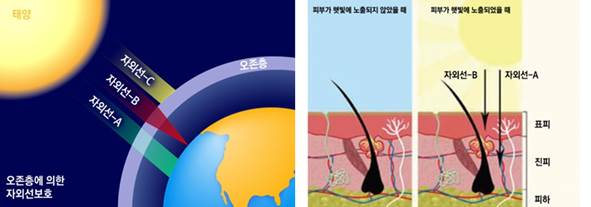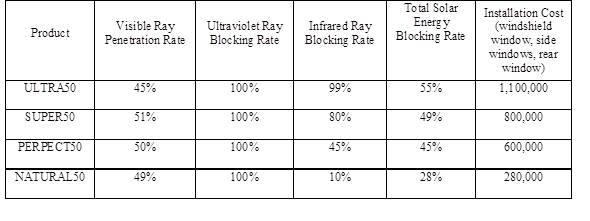Automobile Window-tinting Film Designed to Block the Scorching Sun and Intense Ultraviolet Rays
: Three Criteria for Selecting a Quality Product
● 1% gap may not actually be 1% when it comes to the difference between 100% and 99% ultraviolet rays (UV) blocking
● For a competitive price, SK Skincare Film keeps not only ultraviolet rays at bay but also heat (i.e., infrared rays)
As the spring has come, a growing number of vehicles are heading to the mountain and the river. Many motorists check requirements for safe driving, such as automobile engine oil and tire air pressure, but they often miss out on what is necessary for passengers to travel comfortably: automobile window-tinting film.
Motorists often have window-tinting film installed on the window of their cars, free of charge, as a sales incentive by car dealers when purchasing a new car. If you ask the film supplier to simply 'install tinting firmly on your window' only checking the brand name, you may eventually end up having to pay to have the work done all over again. If you consider your own needs and make the product selection criteria properly in the first place, you can a such a hassle. SKC (Lee Wan-jae, CEO), which produces SK Skincare Film, has summarized the factors to consider when choosing a car window-tinting film product.
1. UV Protection
In the spring, the volume of ultraviolet rays increases significantly. You may think that as long as you tint the window of your car, it will block up to 99% of ultraviolet rays, and so you don’t worry about UV. This supposition is true, but it's not 100% right. This is because there is a big difference between products that offer 99% UV blocking and 100% UV blocking.
Ultraviolet rays that reach the earth surface include ultraviolet ray A (UVA) and B (UVB). A tinting film product that blocks 99% of ultraviolet rays can block UVB, which can cause skin cancer and cataracts. However, such a product fails to block UVA.
UVA is the most intense of ultraviolet rays, and it penetrates most of the stratosphere and ozone , with about 95% of the ray reaching the earth surface. It penetrates deeply into the skin tissue and causes long-term skin damage, such as spots, freckles, black spots, and wrinkles. People who drive for a long time could have more wrinkles or freckles on the left side than the right side of their face, and this is due to UVA. Studies have shown that exposure to UVA for an extended period of time results in tanned skin and increases the risk of skin cancer to a level similar to that of ultraviolet B.

<Types of ultraviolet rays reaching the earth surface (left) and the level of penetration into the skin by the type of ultraviolet rays (right)>
If you are concerned about skin aging, you are advised to choose a product that blocks 100% of UVA and UVB.
2. Heat Insulation
When the temperature rises, the temperature inside your car also rises. If you park your car outdoors on a hot summer day, you will be soaked with sweat because of the sweltering heat. Some of today’s window-tinting products offer a high heat insulation effect, and they are worth paying attention to. People often think that if the color of the tinting film is darker, the heat insulation effect is also higher but this is not necessarily the case. If you wish to choose a highly effective product, be sure to keep in mind the 'infrared ray blocking rate' and the 'total solar energy blocking rate (TSER).’
The infrared ray blocking rate refers to the level at which infrared rays transmitting heat is blocked. The higher the rate, the better it is, but the price increases accordingly. Some products offer an infrared ray blocking rate of 99%. However, since solar energy contains not only infrared rays but also ultraviolet rays and visible rays, it is helpful to check the TSER. The TSER is a comprehensive tally of rays.
The lower the visible light penetration rate and the higher the infrared ray blocking rate, the higher TSER gets. However, since the visible light penetration rate is directly ed to a driver's vision, the rate cannot be lowered without risk. Assuming that the concentration level of film is the same, the higher the TSER, the better it protects skin. Generally, when the visible light penetration rate is 35% to 40%, a TSER reading of 50% or higher is generally considered to be high in quality.
If the heat blocking effect is higher, the temperature inside the car will be less severe and the car will get cooler faster when using the air conditioner. It has a positive effect on fuel economy as well.
3. Visible Light Penetration
According to Article 49 of the Road Traffic Act of Korea, the visible light penetration rate of the windshield window pane should be 70% or higher and the side window panes on the right and left side of the driver's seat should be 40% or higher. To secure privacy in the car, motorists often choose to install a window-tinting film, but a visibility lower than the standard level will reduce the viewing distance, which can be dangerous. It might be okay during daytime, but it can cause bigger problems at night. You may have difficulty seeing in areas where there is not much light. You may also find it difficult to see the rearview mirror when parking. You could lower the window to see the mirror, but it is troublesome to do so during the winter or rainy nights.
You may also wish to remember the concept called visible light reflexibility. This refers to the degree of reflection on glass, and it encompasses internal reflection and external reflection. If the internal reflection level is high, the driver will be reflected on the glass and thus may not be able to see outside clearly. A higher external reflection causes higher reflection on the glass, which can temporarily blind pedestrians and motorists due to glaring light emitted from the glass.
4. SK Skincare Film Developed with SKC's 40-year Technology
SKC launched SK Skincare Film in 2015 by banking on the technology it accumulated over 40 years since developing PET film in 1977. This product, regardless of the price range, boasts the capacity to block 100% of all harmful ultraviolet rays including UVA. The product’s heat insulation rate is also high. A comparative test in which a thermal infrared lamp applies heat to ice cream placed in glass boxes shows a big difference between the ice cream in an ordinary glass box and the ice cream in a glass box made with SK Skincare Film.
Video of comparative test on heat insulation effect of SK Skincare Film https://goo.gl/lxsOh9

<Results of heat insulation effect test of SK Skincare Film (The right one in the picture is the result of testing with SK Skincare Film)>
Notably, SK Skincare Film is more competitive in price as well. When an entire car is to be installed with the top-of-the-line ULTRA product, it will cost 1,100,000 won, which is cheaper than rival products. If you consider performance as well as price, SK Skincare Film is a smarter choice. From now on, be sure to remember UV blocking rate, heat block rate, visible light penetration rate, and SK Skincare Film.

[Attachment 1] Monthly average UVB level for six years (2010~2015) (_ base_d on surveys at five observatories of the Korea Meteorological Administration, unit: mWm)

[Attachment 2] SK Skincare Film being installed

